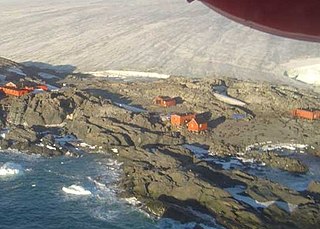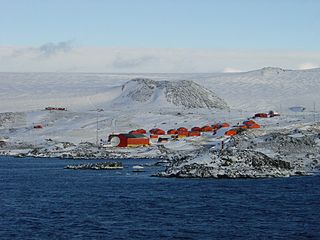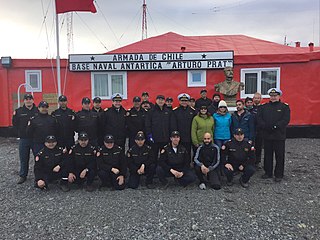
The South Shetland Islands are a group of Antarctic islands with a total area of 3,687 km2 (1,424 sq mi). They lie about 120 kilometres north of the Antarctic Peninsula, and between 430 and 900 km southwest of the nearest point of the South Orkney Islands. By the Antarctic Treaty of 1959, the islands' sovereignty is neither recognized nor disputed by the signatories and they are free for use by any signatory for non-military purposes.

Palmer Station is a United States research station in Antarctica located on Anvers Island, the only US station located north of the Antarctic Circle. Initial construction of the station finished in 1968. The station, like the other U.S. Antarctic stations, is operated by the United States Antarctic Program (USAP) of the National Science Foundation. The base is about as distant from the equator as Fairbanks, Alaska.

Livingston Island is an Antarctic island in the Southern Ocean, part of the South Shetlands Archipelago, a group of Antarctic islands north of the Antarctic Peninsula. It was the first land discovered south of 60° south latitude in 1819, a historic event that marked the end of a centuries-long pursuit of the mythical Terra Australis Incognita and the beginning of the exploration and utilization of real Antarctica. The name Livingston, although of unknown derivation, has been well established in international usage since the early 1820s.

Base General Bernardo O'Higgins Riquelme, also Base Libertador General Bernardo O'Higgins Riquelme, or shortly Bernardo O'Higgins, named after Bernardo O'Higgins, is a permanently staffed Chilean research station in Antarctica and the capital of Antártica Commune. It lies at an elevation of 13 m, about 30 km south-west of Prime Head, the northernmost point of the Antarctic Peninsula, at Cape Legoupil.
The King Sejong Station is a research station for the Korea Antarctic Research Program that is named after King Sejong the Great of Joseon (1397–1450).

Multiple governments have set up permanent research stations in Antarctica and these bases are widely distributed. Unlike the drifting ice stations set up in the Arctic, the research stations of the Antarctic are constructed either on rocks or on ice that are fixed in places.

Base Presidente Eduardo Frei Montalva is the most important Antarctic base of Chile. It is located at Fildes Peninsula, an ice-free area, in front of Fildes Bay, at the west end of King George Island, South Shetland Islands. Situated alongside the Escudero Station and only 200 metres (660 ft) from the Russian Bellingshausen Station, it is at an altitude of 10 metres (33 ft) above sea-level. The base is located in the Chilean commune of Antártica, which is the Antarctic territory claimed by Chile.

The Teniente Luis Carvajal Villaroel Antarctic Base is a seasonal Chilean Antarctic base on the south-west tip of Adelaide Island, in Graham Land off the west coast of the Antarctic Peninsula. The nearest land is the Magallanes – the station is in the Antarctic territory claimed by Chile.

San Martín Base is a permanent, all year-round Argentine Antarctic base and scientific research station named after General José de San Martín, the Libertador of Argentina, Chile and Perú. It is located on Barry Island, Marguerite Bay, Antarctic Peninsula.

The Chilean Antarctic Territory or Chilean Antarctica is a part of West Antarctica claimed by Chile. It comprises the region south of 60°S latitude and between longitudes 53°W and 90°W, partially overlapping with the Antarctic claims of Argentina and the United Kingdom. The Antártica commune is administered by the Cabo de Hornos municipality in the South American mainland.

The Estación Científica Antártica Ruperto Elichiribehety is an Uruguay summer research station in Antarctica, established by the Uruguayan Antarctic Institute on December 22, 1997 on the Antarctic Peninsula.

Captain Arturo Prat Base is a Chilean Antarctic research station located at Iquique Cove, Greenwich Island in the South Shetland Islands, Antarctica.
Professor Julio Escudero Base is a permanent Chilean Antarctic research base. It is located on King George Island near Base Presidente Eduardo Frei Montalva and the civilian settlement of Villa Las Estrellas. It lies within the Antártica Chilean commune funded by the Antarctic Institute of the Ministry of Foreign Relations.

Cape Shirreff is a prominent cape at the north end of the rocky peninsula which separates Hero Bay and Barclay Bay on the north coast of Livingston Island, in the South Shetland Islands of Antarctica. The cape was named by Edward Bransfield in 1820 after Captain William H. Shirreff, the British commanding officer in the Pacific at that time.

Shirreff Base is a seasonal field station in the Southern Ocean operated by the U.S. National Oceanic and Atmospheric Administration (NOAA) and opened in 1996. It is situated on the east side of Cape Shirreff on Ioannes Paulus II Peninsula on Livingston Island in the South Shetland Islands off the Antarctic peninsula.

Deception Station is an Argentine antarctic base located at Deception Island, South Shetland Islands.

Risopatrón Base, also Luis Risopatrón Base, is a small Chilean Antarctic research base in the northwest of Robert Island in the South Shetland Islands, Antarctica situated on the isthmus linking Coppermine Peninsula to Alfatar Peninsula and bounded by Carlota Cove to the north and Coppermine Cove to the south. Established as a refuge in 1949 and opened as a base in 1954, the facility supports summer research in geology, geophysics and terrestrial biology.

Gabriel de Castilla Base is a Spanish research station located on Deception Island, South Shetland Islands, Antarctica. The station was constructed in late 1989. The station is named for Gabriel de Castilla, a 17th century Spanish navigator and according to some reports the first person to sight the mainland of Antarctica.
The Collins base is an Antarctic shelter located in the Collins Glacier that is in the Collins Bay in the Fildes Peninsula, King George Island. It was inaugurated at the 2006-2007 season and is administrated by the Instituto Antártico Chileno (INACH).
Yelcho Base is a Chilean Antarctic research base. It is located on the shore of the South Bay, Doumer Island.


















